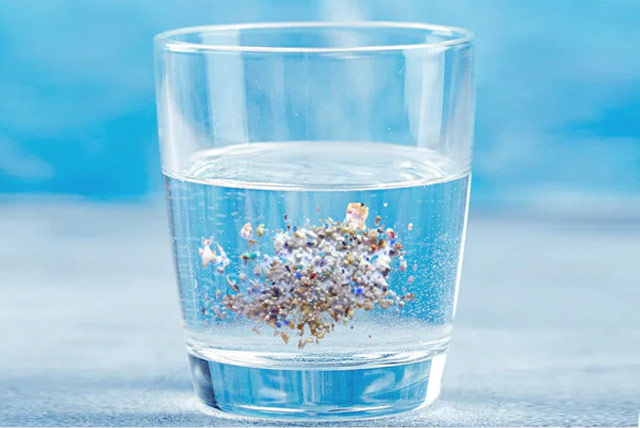Ever wondered what happens to all that plastic we use? Unfortunately, some of it ends up in surprising places – like our drinking water! Tiny plastic fragments, called microplastics, are a growing concern for many reasons.
Studies show that 93% of bottled water samples and 83% of tap water samples around the world contain microplastics, which has prompted many homeowners to ask: “How can I remove microplastics from my drinking water?” This guide will walk you through what microplastics are, why they matter, and, most importantly, the steps you can take to ensure your water is as clean and safe as possible.
What Are Microplastics?
Microplastics are pieces of plastic debris that are smaller than 5 millimeters and larger than 100 nanometers (0.0001 millimeters). These particles originate from various sources, including the breakdown of larger plastic items, microbeads found in personal care products, and synthetic fibres from clothing. Unfortunately, due to their small size, microplastics easily pass through water treatment facilities, making their way into our water systems.
There are two main types of microplastics:
- Primary Microplastics: These are designed to be small, such as the microbeads found in cosmetics and skincare products.
- Secondary Microplastics: These form when larger plastic waste breaks down due to environmental exposure, like sunlight and wave action.
According to a 2018 study by the World Health Organization (WHO), microplastics are widespread in both surface water and groundwater, and it is estimated that a typical person could be ingesting up to 5 grams of plastic per week, equivalent to the weight of a credit card.
How Do Microplastics Affect Human Health?
Scientists are actively investigating the long-term health effects of microplastic exposure. While studies have shown the presence of microplastics in human tissues, more research is needed to establish a definitive link between microplastic exposure and specific health conditions. Here’s what we know so far:
Potential Health Risks:
- Ingestion and Inhalation: Microplastics can be ingested through contaminated seafood and water, or inhaled as airborne particles. Once inside the body, they can accumulate in various organs and tissues.
- Chemical Exposure: Many plastics contain additives like phthalates and bisphenol A (BPA), which have been linked to various health issues, including endocrine disruption, reproductive problems, and cancer.
- Inflammation and Tissue Damage: Microplastics can trigger inflammation and damage to tissues, potentially leading to chronic diseases.
- Respiratory Problems: Inhaling microplastics can irritate the lungs and exacerbate respiratory conditions.
- Endocrine Disruption: Some microplastics can mimic or interfere with hormones, disrupting the body’s natural balance and potentially affecting reproductive health and development.
Effective Ways to Remove Microplastics from Water
There’s still a lot to learn about microplastics. However, that doesn’t have to stop you from taking action to protect your drinking water quality. Reverse osmosis (RO) system is highly effective water filter for removing microplastics from drinking water. These systems work by forcing water through a semi-permeable membrane, filtering out contaminants larger than water molecules. This membrane acts as a molecular sieve, allowing pure water molecules to pass through while rejecting contaminants such as salts, minerals, THMs, bacteria, and microplastics.
The process begins by applying high pressure to the water, which drives it against the membrane. The pores in a reverse osmosis membrane are extremely small, typically around 0.0001 microns in size. Microplastics, which range from 1 micron to as small as 0.1 microns, are too large to pass through these pores and are retained on the other side.
RO systems offer several advantages, including their ability to remove a very high percentage of contaminants, making them ideal for producing pure water.
Are Microplastics Present in Bottled Water?
You might assume that bottled water is a safer alternative to tap water when it comes to avoiding microplastics, but research shows that’s not necessarily the case. In fact, a significant number of bottled water samples have been found to contain microplastics.
A 2018 study by Orb Media tested bottled water from some of the world’s most popular brands and discovered that 90% of the samples contained microplastics.
These findings have raised concerns about the quality of bottled water, especially since many people believe it to be a purer alternative to tap water. The sources of these microplastics in bottled water can vary, but they likely come from the plastic packaging itself. Over time, small plastic particles may shed from the bottle or cap, especially when exposed to heat, light, or other environmental factors.
Moreover, bottled water manufacturers often use large-scale filtration methods, but these systems aren’t always designed specifically to remove microplastics.
Additional Steps to Reduce Microplastics in Your Water Supply
In addition to filtration, there are other practical steps homeowners can take to reduce microplastic contamination:
- Reduce Plastic Use: The average person generates over 30 kilograms of plastic waste per year. By switching to reusable alternatives—like stainless steel water bottles, glass containers, and cloth shopping bags—you can help reduce plastic pollution.
- Proper Waste Disposal: Avoid flushing items like synthetic wipes or plastic particles down the drain. Use waste bins for proper disposal and prevent microplastics from entering the water system.
- Use a Laundry Ball or Filter: According to Friends of the Earth, a single load of synthetic clothing can release up to 700,000 microplastic fibres. Use laundry filters or microfiber-catching devices to prevent these fibres from entering your wastewater.
Take Action for Cleaner Water Today!
Microplastics might be tiny, but they pose a significant threat to our health and environment. By understanding the problem and taking action, we can help protect ourselves and our planet.
At Hydrotech Water Services, we’re passionate about providing high-quality water filtration solutions for Irish homes. We offer a wide range of RO filters certified to remove microplastics, ensuring you enjoy clean, safe drinking water for your family. By choosing filtered water, you can reduce your exposure to microplastics and enjoy the benefits of clean, great-tasting water directly from your tap.

